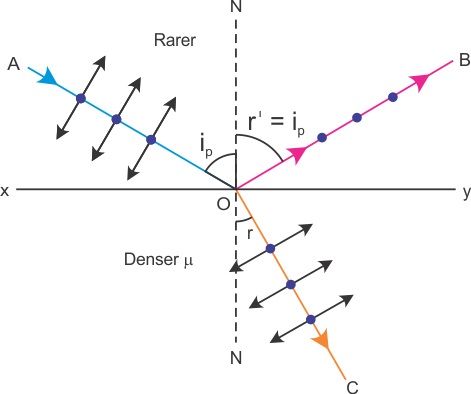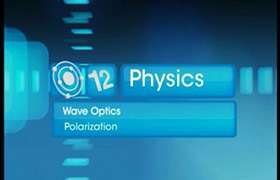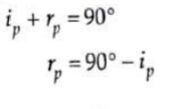CBSE Class 12-science Answered
pl explain polarisation by reflection with diagram
Asked by Rajeev | 21 Feb, 2016, 11:59: PM
When polarized light is reflected from a surface, the reflected light may be completely polarised, partially polarized or unpolarized. This would depend on the angle of reflection.
If the angle of incidence is 0º or 90º, the reflected beam remains unpolarized. For angles of incidence between 0º and 90º, the reflected beam is polarized to varying degree.
The angle of incidence at which the reflected light is completely plane polarized is called polarizing angle or Brewster's angle. It is represented by ip. The value of ip depends on the wavelength of light used. Therefore the complete polarization is possible only for monchromatic light.

In the above figure, unpolarized light incident along AO at  on the interface XY separating air from a medium of refractive index μ. The light reflected along OB is completely plane polarized.
on the interface XY separating air from a medium of refractive index μ. The light reflected along OB is completely plane polarized.
 on the interface XY separating air from a medium of refractive index μ. The light reflected along OB is completely plane polarized.
on the interface XY separating air from a medium of refractive index μ. The light reflected along OB is completely plane polarized.The vibrations of electric vector perpendicular to the plane of incidence always remain parallel to the reflecting surface. Therefore condition of their reflection is not changed with the change in the angle of incidence. However, the other set of oscillations of electric vector in the plane of incidence make different angles with the reflecting surface, as the angle of incidence of unpolarized light is changed. At the polarizing angle (ip), most of these vibrations of electric vector get transmitted and are not reflected. hence, light reflected along OC is a mixture of polarized light and unpolarized light i.e., it is partially polarized.
Therefore, the reflected light contains vibrations of electric vector perpendicular to the plane of incidence. Hence the reflected ligth is completely plane polarized in a direction perpendicular to the plane of incidence.
Answered by Faiza Lambe | 22 Feb, 2016, 12:52: PM
Concept Videos
CBSE 12-science - Physics
Asked by arjunsah797 | 15 May, 2022, 01:18: PM
CBSE 12-science - Physics
Asked by ykadiya99 | 18 May, 2020, 06:26: PM
CBSE 12-science - Physics
Asked by abhitailor158 | 03 Mar, 2019, 06:02: PM
CBSE 12-science - Physics
Asked by agarrajeev06 | 15 Jan, 2019, 05:42: PM
CBSE 12-science - Physics
Asked by nehanithin25 | 17 Aug, 2018, 01:52: PM
CBSE 12-science - Physics
Asked by Topperlearning User | 04 Jun, 2014, 01:23: PM
CBSE 12-science - Physics
Asked by Topperlearning User | 13 Jun, 2014, 12:51: PM
CBSE 12-science - Physics
Asked by Topperlearning User | 13 Jun, 2014, 12:56: PM
CBSE 12-science - Physics
Asked by Topperlearning User | 13 Jun, 2014, 01:12: PM
CBSE 12-science - Physics
Asked by Topperlearning User | 04 Jun, 2014, 01:23: PM






